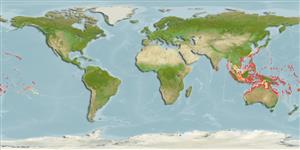Environment: milieu / climate zone / depth range / distribution range
экология
морской ассоциированный с рифами; пределы глубины 0 - 36 m (Ref. 1602). Tropical; 30°N - 30°S, 77°E - 124°W
Indo-Pacific: Sri Lanka to the Hawaiian, Marquesan and Ducie islands, north to southern Japan, south to Lord Howe and Rapa Islands; throughout Micronesia.
Size / Вес / Возраст
Maturity: Lm ? range ? - ? cm
Max length : 20.0 cm TL самец/пол неопределен; (Ref. 9710)
колючие лучи спинного плавника (общее число) : 12 - 13; членистые (мягкие) лучи спинного плавника (общее число) : 24 - 28; колючие лучи анального плавника: 3; членистые (мягкие) лучи анального плавника: 20 - 23. Body is white with orange to orange-brown oblique bands on the sides. Two broad yellow-edged black bars are on the head; one running across the eye and another on the snout (Ref. 4855). Snout length 2.6-3.2 in HL. Body depth 1.3-1.6 in SL (Ref. 90102).
Occur in clear waters and coral-rich areas of lagoon and seaward reefs. However, only common in seaward reefs (Ref. 1602). Benthopelagic (Ref. 58302). Juveniles are solitary, living among branching corals, while adults are almost always in pairs and are home-ranging. Feed exclusively on coral tissue (Ref. 1602). Oviparous (Ref. 205). Form pairs during breeding (Ref. 205). Minimum depth reported taken from Ref. 128797.
Life cycle and mating behavior
половая зрелость | размножение | нерест | икра | Fecundity | личинки
Distinct pairing (Ref. 205). Monogamous mating is observed as obligate, genetic and social (Ref. 52884).
Myers, R.F., 1991. Micronesian reef fishes. Second Ed. Coral Graphics, Barrigada, Guam. 298 p. (Ref. 1602)
Статус Красного Списка МСОП (Ref. 130435: Version 2024-2)
Угроза для людей
Harmless
Использование человеком
рыболовство: не имеет хозяйственного значения; аквариум: коммерческий
дополнительная информация
инструменты
Специальные отчеты
Скачать в формате XML
ресурсы в Интернет
Estimates based on models
Preferred temperature (Ref.
123201): 24.8 - 29.3, mean 28.4 °C (based on 2134 cells).
Phylogenetic diversity index (Ref.
82804): PD
50 = 0.5000 [Uniqueness, from 0.5 = low to 2.0 = high].
Bayesian length-weight: a=0.02630 (0.01594 - 0.04341), b=3.02 (2.88 - 3.16), in cm total length, based on LWR estimates for this species & Genus-body shape (Ref.
93245).
Trophic level (Ref.
69278): 3.3 ±0.61 se; based on food items.
устойчивость к внешним воздействиям (Ref.
120179): высокий, минимальное время удвоения популяции до 15 месяцев (Preliminary K or Fecundity.).
Fishing Vulnerability (Ref.
59153): Low vulnerability (10 of 100).
Nutrients (Ref.
124155): Calcium = 87.8 [46.5, 133.3] mg/100g; Iron = 0.762 [0.456, 1.222] mg/100g; Protein = 18.7 [17.6, 19.8] %; Omega3 = 0.116 [0.073, 0.182] g/100g; Selenium = 32.6 [18.7, 60.0] μg/100g; VitaminA = 49.2 [14.9, 161.8] μg/100g; Zinc = 1.32 [0.91, 1.89] mg/100g (wet weight);
